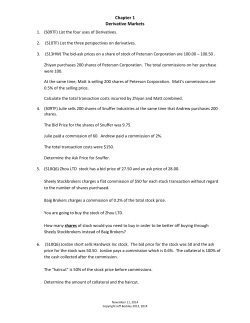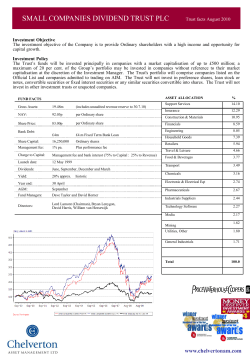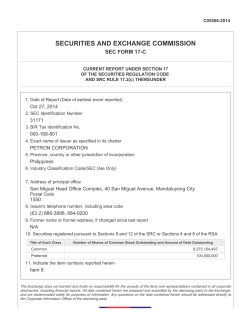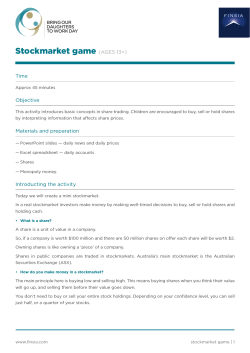
Starting point valuations matter, a lot
Shane Oliver, Head of Investment Strategy & Chief Economist Starting point valuations matter, a lot EDITION 37 – 19 NOVEMBER 2014 axis) against subsequent 10 year returns from Australian bonds based on the Composite All Maturities Bond index (vertical axis). Australian bonds – the higher the bond yield the better 18 Return from bonds over subsequent 10 years, % pa 1950 to present 16 14 Key points > > 12 Starting point valuations – eg yields and price to earnings multiples – are a key driver of potential medium term investment returns. This is particularly so for cash and bonds, and for shares & other growth assets at extremes. 10 At present valuation starting points for term deposits and bonds suggest low medium term returns. For shares they suggest okay returns. 2 Introduction It stands to reason that the cheaper you buy an asset the higher its prospective return will be. However, this is frequently forgotten with investors often tempted to project recent returns into the future regardless of valuations. And there are always issues around the valuation measures themselves. This note looks at the main issues. The cheaper the better A valuation measure for an asset is basically a guide to whether it’s expensive or cheap. Simple valuation measures are price to earnings ratios for shares (the lower the better) and income yields, ie the ratio of dividends, rents or interest payments to the value of the asset (the higher the better). An obvious example of where the starting point valuation matters critically is cash. If the yield or interest rate on offer from a term deposit rate is relatively high then that is good because that is precisely the return you will get. For example, five years ago average term deposit rates for multi-year bank term deposits were around 7% pa with some banks offering deals around 8%. This was not bad for a safe asset in a world of inflation averaging around 2.5%. So the starting point for term deposits then was attractive. Now by contrast, term deposit rates are averaging closer to 3% suggesting that they are not such good value anymore. Trend relationship 8 Jan 1982 15.2% 6 4 Currently 3.3% 0 0 1 2 3 4 5 6 7 8 9 10 11 12 13 14 15 16 17 18 10 year bond yield, % Source: Global Financial Data, Bloomberg, AMP Capital Put simply when bond yields are high they drive high bond returns over the medium term and vice versa. For example when Australian 10 year bond yields in January 1982 were 15.2% it’s not surprising that returns from bonds over the subsequent ten years were 15.4%. Similarly when bond yields were just 3.1% in January 1950, it’s no surprise that returns from bonds over the next 10 years were 3.1%. For shares a similar relationship holds. The following chart shows a scatter plot of the price to earnings ratio for US shares since 1900 (along the horizontal axis) against subsequent 10 year total returns (ie dividends plus capital growth) from US shares. While the relationship is not as smooth as that for bonds because there is much more involved in share returns, it can be seen that it is a negative relationship, ie when share prices are relatively high compared to earnings subsequent returns tend to be relatively low and vice versa. The best time for shares seems to be when PEs are in single digits. At the end of the mid- 1970s bear market the PE had fallen to 7.6 times and over the next ten years US shares returned 15.6% pa. US shares - the lower the PE the better Return over subsequent 10 years, % pa, 1900 to present 25 20 15 10 Trend relationship 5 0 Currently 18.7 times -5 5 10 15 20 25 30 Price to (historic) earnings ratio 35 40 Source: Global Financial Data, Bloomberg, AMP Capital Source: RBA, AMP Capital For government bonds the yield is similarly a good guide to starting point value. Over short term periods bond prices can move up and down and so influence short term returns, but over the medium term the main driver of the return a bond investor will get is what bond yields were when they invested. If the yield on a 10 year bond is 5%, then if you hold the bond to maturity your return will be 5%. Of course a portfolio of bonds will reflect a range of maturities and so the relationship is not as perfect, but it can be seen in the next chart which shows a scatter plot of Australian 10 year bond yields since 1950 (along the horizontal The next chart shows the same for Australian shares but only back to 1962 as an Australian PE series is not available prior to the 1960s. Again there is the expected negative relationship between the level of the PE and subsequent total returns (based on the All Ords Accumulation index). For example, at the end of the mid-1970s bear market in September 1974 the PE was just 5.4 times which was a great time to buy shares as over the next ten years Australian shares had a total return of 21.8% pa. rose for another four years. The best way to guard against this is to have a thorough asset allocation process that depends on more than just valuations. Australian shares – the lower the PE the better 30 Return over subsequent 10 years, % pa 1962 to present 25 Third, there is a huge array of valuation measures particularly when it comes to shares. For example the “earnings” in the PE calculation can be actual historic earnings, consensus earnings for the year ahead or earnings that have been smoothed in some way to remove cyclical distortions. All have their pros and cons. For example, the historic PE is based on actual data with no forecasting or manipulation but it can give the wrong signal during a recession as earnings may have collapsed more than share prices and so the PE may not give a reliable buy signal. 20 15 Trend relationship 10 5 Currently 16 times 0 5 10 15 20 Price to (historic) earnings ratio 25 30 Source: RBA, Global Financial Data, AMP Capital There is a dividend yield for Australian shares back to 1900 and the rough relationship in the next chart indicates the higher it is the better the subsequent 10 year share return. Australian shares – the higher the dividend yield the better 30 Return over subsequent 10 years, % pa 1900 to present 25 Finally, the appropriate level of valuation can vary depending on the environment. For example, in a period of low inflation it’s well-known that assets can trade on lower yields as the interest rate/yield structure in the economy falls. This in turn means higher PEs. So low inflation, say down to around 2%, can be good for shares via higher PEs as evident in the next chart for the US. But if inflation goes from “low” to deflation it can be bad as it tends to be associated with poor economic growth and as a result shares trade on lower PEs. Low inflation can allow higher PEs, but not deflation 50 20 US price to (historic) earnings ratio 1900 to present 45 40 15 Trend 35 relationship 30 10 25 5 20 Currently 6% 15 0 2 3 4 5 6 7 8 Grossed up dividend yield, % 9 10 11 Source: Global Financial Data, Bloomberg, AMP Capital The key point is that the starting point matters. Critically for cash, bank deposits and bonds but also for growth assets like shares. Put simply, the higher the yield on offer the better and the lower the price to earnings ratio the better. Why valuation is often forgotten But while this seems obvious it’s often forgotten for three reasons. The first relates to shares but is rather academic and goes back to the efficient market hypothesis which basically posits that the share market rationally reflects all publicly available information at any point in time. From this it follows starting point valuation measures will be no guide to future returns. Quite clearly this is not the case. But for a long time the argument that share markets were efficient drove a set and forget mentality to much investment strategy. The second reason relates to the unfortunate reality that many investors pay too much attention to recent performance, so after a run of strong years investors gain confidence and expect it will continue and vice versa after a run of poor years. This leads many to buy only after good times only to find they have bought when shares are overvalued and therefore find themselves locked into poor returns. And vice versa after bad times. So just when starting point valuations matter the most, they tend to be ignored. Finally, using valuation alone to drive investment decisions can involve pitfalls that can erase confidence in them. Complications to be aware of There are several potential pitfalls with valuation measures that investors should be aware of. First, sometimes assets are cheap for a reason (value traps). This is more often a phenomenon associated with individual shares, eg, a tobacco company subject to impending law suits even though its current earnings are fine. Or high yields may be being financed by debt. These traps can really only be picked up by thoroughly researching the investment. Second, valuation measures are often a poor guide to timing. Eg, in 1996 US shares were starting to look expensive on some measures with Fed Chair Alan Greenspan and Economist Robert Shiller referring to “irrational exuberance” but if an investor sold shares short then they would have lost out as they 10 5 -25 -15 -5 5 US inflation rate, % 15 25 Source: Global Financial Data, Bloomberg, AMP Capital The message from all this is that valuation is important but you ideally need to assess it with other indicators if you are trying to time market moves. The key is to allow that when a range of valuations measures are at an extreme then they are probably providing a signal that should not be ignored. Current valuation signals Right now starting valuation signals are as follows: Bank term deposits – term deposit rates are low so returns will be low, at around 3%. This will remain the case until interest rates start to rise again. Bonds – bond yields are now very low at 2.8% for Australian five year bonds and 3.3% for 10 year bonds and even less internationally pointing to low medium term returns from government bonds. In a world of excess savings, spare capacity and uneven growth it’s hard to get bearish on bonds but low yields nevertheless point to low medium term returns. Shares – PE ratios for shares are no longer dirt cheap, but nor are they at the extreme expensive end suggesting that they are not providing strong signals at present. For US and Australian shares they are in ranges suggesting okay returns. This is particularly so relative to low bond yields. Property – while this note has not focused on property the same basic principles apply, ie the higher the rental yield the better. Over the last few decades property yields have fallen with inflation and interest rates, but this is more so for residential property where gross rental yields are now quite low at around 3-4% compared to commercial property where yields average around 6-7%. So the starting point for commercial property is arguably much better. Dr Shane Oliver Head of Investment Strategy and Chief Economist AMP Capital Important note: While every care has been taken in the preparation of this document, AMP Capital Investors Limited (ABN 59 001 777 591, AFSL 232497) and AMP Capital Funds Management Limited (ABN 15 159 557 721, AFSL 426455) make no representations or warranties as to the accuracy or completeness of any statement in it including, without limitation, any forecasts. Past performance is not a reliable indicator of future performance. This document has been prepared for the purpose of providing general information, without taking account of any particular investor’s objectives, financial situation or needs. An investor should, before making any investment decisions, consider the appropriateness of the information in this document, and seek professional advice, having regard to the investor’s objectives, financial situation and needs. This document is solely for the use of the party to whom it is provided.
© Copyright 2025











